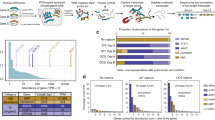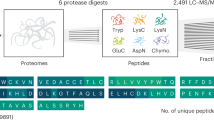Abstract
A human infant brain cDNA library, made specifically for production of expressed sequence tags (ESTs) was evaluated by partial sequencing of over 1,600 clones. Advantages of this library, constructed for EST sequencing, include the use of directional cloning, size selection, very low numbers of mitochondrial and ribosomal transcripts, short polyA tails, few non-recombinants and a broad representation of transcripts. 37% of the clones were identified, based on matches to over 320 different genes in the public databases. Of these, two proteins similar to the Alzheimer's disease amyloid precursor protein were identified.
This is a preview of subscription content, access via your institution
Access options
Subscribe to this journal
Receive 12 print issues and online access
$209.00 per year
only $17.42 per issue
Buy this article
- Purchase on Springer Link
- Instant access to full article PDF
Prices may be subject to local taxes which are calculated during checkout
Similar content being viewed by others
References
Adams, M.D. et al. Complementary DNA sequencing: Expressed sequence tags and human genome project. Science 252, 1651–1656 (1991).
Adams, M.D. et al. Sequence identification of 2,375 human brain genes. Nature 355, 632–634 (1992).
Adams, M.D., Kerlavage, A.R., Fields, C. & Venter, J.C. 3400 expressed sequence tags identify diversity of transcripts in human brain Nature Genet. 4, 256–267 (1993).
Okubo, K. et al. Large scale cDNA sequencing for analysis of quantitative and qualitative aspects of gene expression. Nature Genet. 2, 173–179 (1992).
Khan, A.S. et al. Single pass sequencing and physical and genetic mapping of human brain cDNAs. Nature Genet. 2, 180–185 (1992).
Adams, M.D., Fields, C. & Venter, J.C. Introns in sequence tags. Nature 357, 367–368 (1992).
Kang, J. et al. The precursor of Alzheimer's disease amyloid A4 protein resembles a cell-surface receptor. Nature 325, 733–736 (1987).
Vidal, F., Blangy, A., Rassoulzadegan, M. & Cuzin, F. A murine sequence-specific DNA binding protein shows extensive local similarities to the amyloid precursor protein. Biochem. Biophys. Res. Commun. 189, 1336–1341 (1992).
Wasco, W. et al. Identification of a mouse brain cDNA that encodes a protein related to the Alzheimer-associated amyloid ß protein precursor, Proc. natn. Acad. Sci. U.S.A. 89, 10758–10762 (1992).
Wasco, W. et al. The amyloid precursor-like protein (APLP) gene maps to the long arm of human chromosome 19. Genomics 15, 237–239 (1993).
Altschul, S.F. et al. Basic local alignment search tool. J. molec. Biol. 215, 403–410 (1990).
Uberbacher, E. & Mural, R. Locating protein-coding regions in human DNA sequences by a multiple sensor-neural network approach. Proc. natn. Acad. Sci. U.S.A. 88, 11261–11265 (1991).
Sutcliffe, J.G. mRNA in the mammalian central nervous system. Ann. Rev. Neurosci. 11, 157 (1988).
Puissant, C. & Houdebine, L.-M. An improvement of the single step method of RNA isolation by acid guanidinium-thiocyanate-phenol-chloroform extraction. BioFeedback 8, 148–149 (1990).
Chomczynski, P. & Sacchi, N. Single-step method of RNA isolation by acid guanidinium thyocyanate-phenol-choloroform extraction. Anal. Biochem. 162, 156–159 (1987).
Maniatis, T., Fritsch, E.F. & Sambrook, J. in Molecular Cloning: A Laboratory Manual (Cold Spring Harbor Press, New York, 1982).
D'Alessio, J.M., Noon, M.C., Ley III, H.L. & Gerard, G.F. One-tube double-stranded cDNA synthesis using clones m-mlv reverse transcriptase. Focus 9, 1–4 (1987).
Gubler, U. & Hoffman, B.J. A simple and very efficient method for generating cDNA libraries. Gene 25, 263–269 (1983).
Huynh, T.V., Young, R.A. & Davis, R.W. in DNA Cloning (ed. M. Glover) 49–78 (IRL Press, New York, 1985).
Smith, C.L. et al. Strategies for mapping and cloning macroregions of mammalian genomes. Meth. Enzym. 151, 461–489 (1987).
Kerlavage, A. et al. Analysis and management of data from high-throughput expressed sequence tag projects. Proc. 26th Hawaii Int. Conf. on System Sciences 585–594. (IEEE Computer Society Press, New York, 1993).
Author information
Authors and Affiliations
Rights and permissions
About this article
Cite this article
Adams, M., Soares, M., Kerlavage, A. et al. Rapid cDNA sequencing (expressed sequence tags) from a directionally cloned human infant brain cDNA library. Nat Genet 4, 373–380 (1993). https://doi.org/10.1038/ng0893-373
Received:
Accepted:
Issue Date:
DOI: https://doi.org/10.1038/ng0893-373
This article is cited by
-
The Bermuda Triangle: The Pragmatics, Policies, and Principles for Data Sharing in the History of the Human Genome Project
Journal of the History of Biology (2018)
-
Pivotal Role of Computers and Software in Mass Spectrometry – SEQUEST and 20 Years of Tandem MS Database Searching
Journal of the American Society for Mass Spectrometry (2015)



